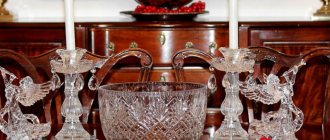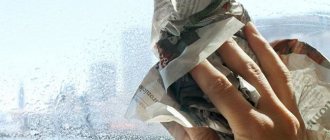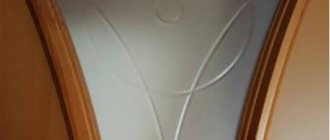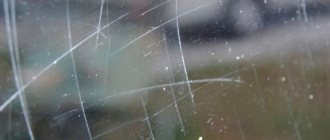Crystal tableware has been valuable for several centuries and the cost of crystal has not fallen; on the contrary, now manual labor has become even more expensive. Do you know how crystal is made and how to distinguish crystal from glass? Do you know that there is colored crystal and double-layer crystal - the crown of glass art?
I can’t imagine a woman indifferent to beautiful dishes, and crystal dishes are very beautiful and also expensive, it always adds “beauty”. Crystal glasses, shot glasses, vases...Crystal dishes have a special energy, warmth, and are pleasant to touch.
Luxurious crystal glasses are always an excellent gift; the online tableware store Posud:meister.ua offers high-quality crystal and glassware.
How to distinguish glass from crystal
Classic crystal contains -24% lead oxide, in some products this substance can be up to 30%.
According to European standards, a glass product that contains lead oxide:
- less than 4% is not crystal and belongs to the “glass” category
- more than 10% belongs to the category “crystal glass”
- 24% - “crystal”
- more than 30% - “crystal with a high content of lead oxide”
The famous Bohemian crystal does not contain lead oxide; instead, potassium-calcium glass is added, and barium crystal is also available.
What are all these additives for? Lead oxide adds nobility to the finished product, it gets a “voice”, a gentle sound from contact, its color is absolutely transparent, crystal products seem warm and pleasant to the touch, crystal products especially shimmer and sparkle in the sun. Only their crystal products can have all these qualities.
Colored crystal and double layer crystal
Less known is colored crystal; products made from colored crystal have all the qualities of crystal. To give crystal color, various metal oxides are added at the manufacturing stage, giving beautiful colors - pure blue, pink, green, purple.
Overlaid crystal has the greatest value; it can be called a work of glass art. This crystal has two layers, one of them is colored and the other is transparent. When the product is ready, the artist removes the top colored layer of crystal during cutting and transparent edges appear. Highly artistic cutting can only be performed by a professional of the highest level; he must be a virtuoso in his field. Therefore, products made from two-layer crystal are the most expensive of their kind.
New in blogs
Fifty kilometers from Bryansk is the small town of Dyatkovo. It is known to the general public in connection with the production of furniture. And the second city-forming enterprise is the Dyatkovo Crystal Factory.
Sometime in the 18th century, for organizational reasons, a large crystal production owned by the Maltsov family was distributed across two territories: Gus Khrustalny and Dyatkovo. Until now, these points are famous for their crystal.
It’s amazing that in Dyatkovo, despite all the hard times after the collapse of the USSR, production is still constantly running. In addition, the city has a crystal museum, whose employees take curious tourists not only through the halls with glasses, but also into the production workshops themselves. It is very interesting!
The workshops are hot and noisy. The story begins in the first workshop. The master takes a drop of the molten mass with a special tube:
Then, blowing air in, it begins to rotate the tube, giving the product the shape of a bubble. Previously, glass was inflated using the power of the lungs - blowing into a tube. Now there is a rubber pump on the handle; air can be supplied by pressing the hand.
The product is lowered into the mold:
For new models, temporary wooden molds are made - they are enough for 10-12 products. For those entering production - metal ones.
It turns out this:
Another master removes the workpiece and separates the upper part. All “excess” glass is melted down.
He warms up the edge of the product and trims it, makes a nose and gives a special shape, if necessary.
Handles for jugs are made in a very interesting way: One of the craftsmen feeds a drop of hot mixture from above. The second master helps him get to the right place, at the lower point of attachment of the handle and body of the jug.
Then the fiery column of molten crystal mass is cut:
And with a quick movement it attaches to the second point:
But they make the nose - one movement from bottom to top. Masters work very long hours and have a narrow specialization. Every movement is jewelry.
The finished product is hardened in an oven:
On large items (for example, some huge vases), two people work:
Sometimes fines are transported directly in the form of blanks. A hole from the tube is visible in the center of the product. This upper part will then be cut off and you will get something like rosettes for jam.
And in the neighboring workshop, designs are applied to the products - special diamond cutters are used for this.
Master's workplace. Pads for the elbows and a diamond rotating disk in the center - for applying a pattern.
After application, the pattern is matte; to obtain smoothness and gloss, the product is treated with an acid solution.
And something like this happens. For example, a rat set:
Crystal Museum in Dyatkovo
Crystal Bell
Exhibits
In the crystal church of Dyatkovo
Rating of crystal glassware manufacturers
Our list is based on customer reviews and expert recommendations.
Lalique
A French brand that has been known on the international glassblowing market for over 130 years. Today it produces not only dishes made of natural crystal and crystal glass, but also all kinds of decorative items and chandeliers.
The cut and design of Lalique glasses are especially appreciated by lovers of elite strong drinks. Good champagne, wine aged for many years, cognac is more pleasant to drink from beautiful festive-looking glassware.
Bohemia
Famous Czech crystal, known since Soviet times. And today, glasses and shot glasses do not lose their popularity; they are stored in the most visible place and used for festive serving.
What gives color?
Crystal can be either transparent or colored. It gets its tint coloring with the help of special additives in its composition. For example, blue is obtained by adding cobalt, red - cadmium or gold, if you add silicon, you get pink crystal, if iron - yellow or bluish-green, copper oxide and manganese oxides give purple and green shades. When adding pure manganese, we get a bright yellow color, grass-green with chromium, and yellow-green with uranium.
Some types of decoration are used to decorate crystal. This is primarily decoration using gold (the most common). Foil is taken and fused inside the glass or covered on the outside. A simpler and cheaper way is painting with gold oxide. The second method of decoration is etching (satinizing). Either the entire surface or just the design is etched. The technique is based on hydrofluoric acid treatment, which makes the glass more shiny. For those who like a matte surface, use the matting technique using fine-grained sand.
Crystal is
Crystal is a type of glass. Crystal can also be called pure, high-quality glass. Modern glassmaking is more than 5 thousand years old, but the production technology remains the same and has not undergone any special changes. Any alcoholic drink - wine or champagne - takes on a completely different “sound” when a crystal glass is filled with it.
The history of crystal begins in the 17th century in England. Here they began to add lead to the glass, which gave the crystal strength and shine. The walls of the vessel had a high refractive index of light, and therefore all the colors of the rainbow could be observed. Due to its strength, crystal is easy to cut. Typically, all raw materials are cooked at a temperature of 1500 degrees Celsius. The liquid form of glass is then processed manually or using special machines.
Ordinary glass is produced by combining oxides of various metals with quartz. The main constituent element is silicon dioxide, which is obtained from quartz sand. In the past, either chalk or lime was also added to make the glass thin and have a better shine. Now this technology is not used or in rare cases.
Traditionally, crystal is cut with a diamond cut, as the material is softer and more amenable to alteration. Another method of decoration is engraving, but the resulting design cannot be polished. Any applied pattern does not affect the taste of alcohol in any way.
Features of care
Detergents with coarse and solid fractions are not used to clean crystal. They scratch this natural material. Fresh and dried food debris and other stains from crystal glassware are removed using a simple soap solution. Objects are dipped into it and left for a couple of minutes, and then wiped with a soft sponge and rinsed with water.
Strongly ingrained dirt can be removed using table salt.
The dishes, shimmering in the sun with all the colors of the rainbow, are washed by hand. It is not advisable to put it in the dishwasher along with pots, pans and other kitchen utensils. Contrast showers, very hot or ice water are also contraindicated for her.
Crystal loves to be gently wiped with a dry soft towel or napkin after washing. Crystal glasses, shot glasses and wine glasses cannot be placed on top of each other, as the lower objects may simply crack under the weight of the upper ones.











